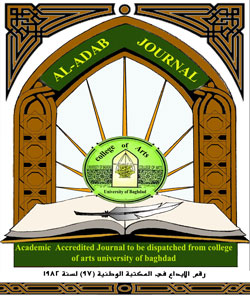The guiding function of the image in the experience of Wafa Abdul Razzaq poetry
(Do not hesitate to cast crystals) model
DOI:
https://doi.org/10.31973/aj.v0i134.1009Keywords:
Image, steering, secured, subjectAbstract
And this is what we try to detect and revealed in a new reading and different experience of the Iraqi poet Almgujp from the inside of the pain of her homeland, which was surrounded by the forces of demolition and the courtyard and the void became a playground in which to fight, and fights on the cloves of Henna with the blood of his sons wolves jungle, poet watching this demolition hurts from the inside Vnrsd Refraction sometimes and sometimes the revelation in a realistic vision to reveal the silent about him, and cover hidden and hidden behind the cloak of religion and doctrine and party.
Through our study of the image orientation function in the poet's office, we found that the effectiveness of the image stems from within the poetic text through four main elements: Its ability to direct the recipient based on its components, which includes the image material and its content, and the way the images in which our poet originated are formed the strength of the emergence of images and its emergence has been adopted poet in her office to the image in a large and strong. the ability of the poet to combine antagonisms and invest in the correspondence of the senses and the intensification of the symbolic image and support arguments to convince the recipient of the important and fundamental thing in the direction of improvement or justification.
Downloads
References
The secrets of rhetoric, Abdel-Qaher al-Jarjani, T: Abdel Hamid Hindawi, Dar Al-Kutub Al-Alami - Beirut, 1st edition, 2001.
Theoretical foundations for building reading networks for Hajj texts, within the Hajj, its concept and its fields, Abdulaziz Lahwaidaq, Modern Books World, 2010, 1st floor.
Types of photo, Dr. Jamil Hamdaoui, newspaper, the intellectual
http://www.almothaqaf.com/268-qadaya2015/895720
The New Rhetoric between Imagination and Circulation, Dr. Muhammad Al-Omari, East Africa, Casablanca, Morocco, 1999.
Linguistic Communication and Language Functions in Linguistics (Modern Linguistics, Preliminary Reading), Roman Jacobson, T: Michel Zakaria, Arab Foundation for Studies and Publishing Beirut, 1st edition, 1985
Pilgrims in the Qur'an through its most important stylistic characteristics, Abdullah Sawlah, College of Arts publications Mannounah, Part 1, 2001
Pilgrimage of the image in the political rhetoric of Imam Ali, may God be pleased with him, Dr. Kamal Al-Zamani, Modern Book World, Irbid-Jordan, 2012, 1st edition
Tags and text science Dr. Munther Ayyash, Center for Urban Development, Dar Mahaba - Damascus, 2009
The semiotics of the publicist image, Samir Al-Zoghbi, the civilized dialogue
http://www.m.ahewar.org/s.asp?aid=292693&r=0
Wafaa Abdel Razzaq Poetry, Variety of Formation and Effectiveness of Discourse, Dr. Ikhlas Mahmoud Abdullah, Linda House for Printing, Publishing and Distribution, Damascus, 1st edition -2018
Poetic Image in Modern Arab Criticism, Bushra Musa Salih, Arab Cultural Center, 1 st edition 1994.
The artistic image in the critical and rhetorical heritage of the Arabs, Jaber Asfour, the Arab Cultural Center, Dar Al-Bayda, 1992, 3rd edition.
Artistic Values and Aesthetic Values, Roman Engarden, T. Saeed Ahmad Al-Hakim, Journal of Foreign Culture, Third Issue, 1986, Baghdad
The Complete Poetry Collection, Wafaa Abdel Razzaq's Poetry, The Heritage of Crystal Festivals, 1st Floor, 2018
The Platform for Bullying and the Lore of Writers, Abu al-Hasan Hazim al-Qartajni, Islamic Dar al-Gharb 1981
Cognitive Criticism in the Rhetorical Lesson - The Format of the Statement, Dr. Azad Hassan Sheikho, Modern World of Books Jordan, 2013
Cognitive Criticism in the Rhetorical Lesson - The Format of the Statement, Dr. Azad Hassan Sheikho, Modern World of Books Jordan, 2013
Downloads
Published
Issue
Section
License
Copyright and Licensing:
For all articles published in Al-Adab journal, copyright is retained by the authors. Articles are licensed under an open access Creative Commons CC BY 4.0 license, meaning that anyone may download and read the paper for free. In addition, the article may be reused and quoted provided that the original published version is cited. These conditions allow for maximum use and exposure of the work.
Reproducing Published Material from other Publishers: It is absolutely essential that authors obtain permission to reproduce any published material (figures, schemes, tables or any extract of a text) which does not fall into the public domain, or for which they do not hold the copyright. Permission should be requested by the authors from the copyrightholder (usually the Publisher, please refer to the imprint of the individual publications to identify the copyrightholder).
Permission is required for: Your own works published by other Publishers and for which you did not retain copyright.
Substantial extracts from anyones' works or a series of works.
Use of Tables, Graphs, Charts, Schemes and Artworks if they are unaltered or slightly modified.
Photographs for which you do not hold copyright.
Permission is not required for: Reconstruction of your own table with data already published elsewhere. Please notice that in this case you must cite the source of the data in the form of either "Data from..." or "Adapted from...".
Reasonably short quotes are considered fair use and therefore do not require permission.
Graphs, Charts, Schemes and Artworks that are completely redrawn by the authors and significantly changed beyond recognition do not require permission.
Obtaining Permission
In order to avoid unnecessary delays in the publication process, you should start obtaining permissions as early as possible. If in any doubt about the copyright, apply for permission. Al-Adab Journal cannot publish material from other publications without permission.
The copyright holder may give you instructions on the form of acknowledgement to be followed; otherwise follow the style: "Reproduced with permission from [author], [book/journal title]; published by [publisher], [year].' at the end of the caption of the Table, Figure or Scheme.











